The Art of Burning
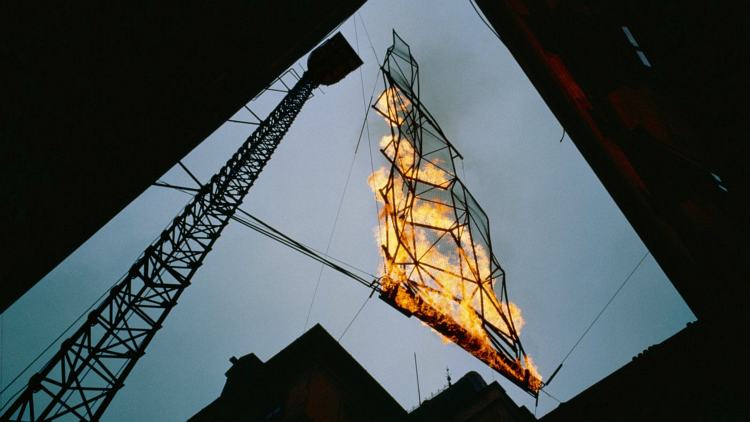
Featured image: The Blazing Wing (1980) by Coop Himmelb(l)au, a studio founded by Wolf D. Prix, Helmut Swiczinsky, and Michael Holzer. The Blazing Wing is a performance that embraces presence through the process of (physical) disappearance. (Gerald Zugmann)
There is much to be said about the process of burning and the feeling of release that is associated with its fleeting events. We normally centre our ideas about burning on the disappearance of physicality—something we hold onto as embodied, connected beings. But, in the midst of its fiery destruction, there is also an opportunity to deviate from our normal ideas and redefine our relationship.
A history of fire
Fire generates heat. It keeps us warm and kills bacteria. But the act of burning, as a ceremony, is usually concealed from the eyes of the public. It’s a physical threat and has personal and historical occurrences associated with it: the eradication of books, death, trauma, cities engulfed in flames, violent oppressors hiding genocidal evidence, and so on. Even in making things physically disappear on request, it causes unwanted environmental damage. All of this has brought negative connotations to the fabric of our intuitions about fire.
Fire is used openly as part of a ceremony, say, for Sechseläuten, when the people of Zürich symbolically burn winter prior to spring, or Guy Fawkes Night, when the people of the United Kingdom burn effigies of Catholic, anti-parliamentarian Guy Fawkes.
But, even then, there’s a strong sense that we’re leaving something behind as opposed to continuing it: a release, a catharsis, a cleansing, a moving-on.
Yet, I argue, we can redirect mindsets away from so-called destruction and towards other possibilities, from which new ideologies may emerge. But what? How can we attach a constructive perspective to destruction? And why?
Is there a philosophy of burning to orientate ourselves towards?
Community burning
In his magnum opus, Being and Time, Martin Heidegger argues that the most-certain possibility of existence is death; but, as a result, that ‘man’ is forced to think about life. As such, we are offered the role of ‘Being’, on the condition we establish the essence of our existence first through a mode of being called ‘Dasein’.
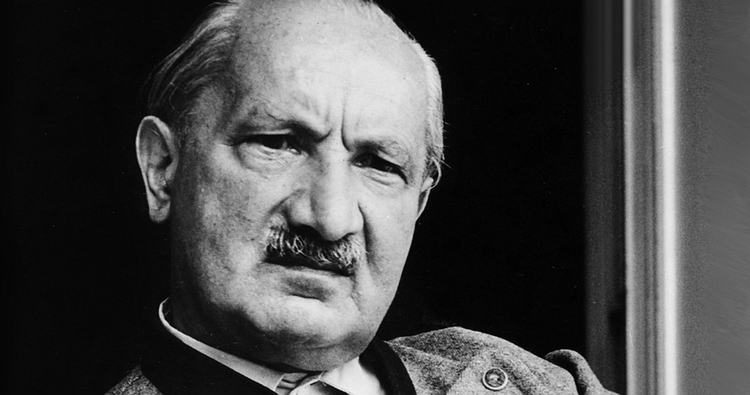
Martin Heidegger argued that we must understand ourselves through Dasein first before art becomes a matter of truth.
The essence of art, through Dasein, is constituted in the ‘becoming and happening’ of truth, where the art’s truth is what matters to a community: members of that community must reflect on the importance of their art. Thus, Heidegger anchored art, phenomenologically, to people. His view can be expressed as follows:
Art, then, is something that truth can ‘spring forth’ from if the art is embedded in historical contexts of what is and what matters to a community.
What does this mean for burning? That the act of burning as an art has space to grow if it is determined that burning has importance in our cultural situations. Heidegger’s ontology, therefore, offers theoretical space for an art of burning.
The dialectics of burning
Heidegger’s thoughts on the fundamental states of being were a major influence on much of Jacques Derrida’s ‘deconstructionism’, specifically on his critique on the ‘metaphysics of presence’. Its relevance to burning will become apparent soon.
Philosophers in the Western tradition have become fixated on pairs of things: namely, a binary distinction between primary properties and their secondary derivatives. They use this frozen structure of opposition to conceive of ‘truth’, ‘identity’, ‘being’, ‘essence’, and ‘reality’ in some things (and not in others). But, Derrida argued, this endeavour is incomplete because we also require notions such as ‘absence’ and ‘difference’.
Derrida focused on language. He criticised how we try to reduce the perceivable (in experience) to the intelligible (in language). The split is wrong. While we may group thoughts together with the signifier ‘water’, we don’t imagine a universal representation of water by itself. Rather, we think of the innumerable things it could signify (e.g. ‘H2O’, ‘rain’, ‘swimming’ ‘pool’, ‘water’ … ). The relationship between signifier and signified, therefore, doesn’t exist; and speech shouldn’t be treated as something which necessarily comes before language.
Indeed, pairs of things, like ‘experience’ and ‘language’, should be avoided in any system of representation. This extends to terms such as ‘perception’ and ‘understanding’; ‘myself’ (unified self) and ‘the world’ (external world), à la René Descartes; ‘man’ and ‘woman’; ‘culture’ and ‘nature’; ‘appearance’ and ‘essence’, argued for by Plato but denied by the likes of David Hume and Friedrich Nietzsche; and ‘good’ and ‘evil’, concepts so common across cultures.
A similar denial of dialectic can now be applied to ‘construction’ and ‘destruction’, wherefrom burning freely straddles a creative plane unprohibited by slanderous binary distinctions.
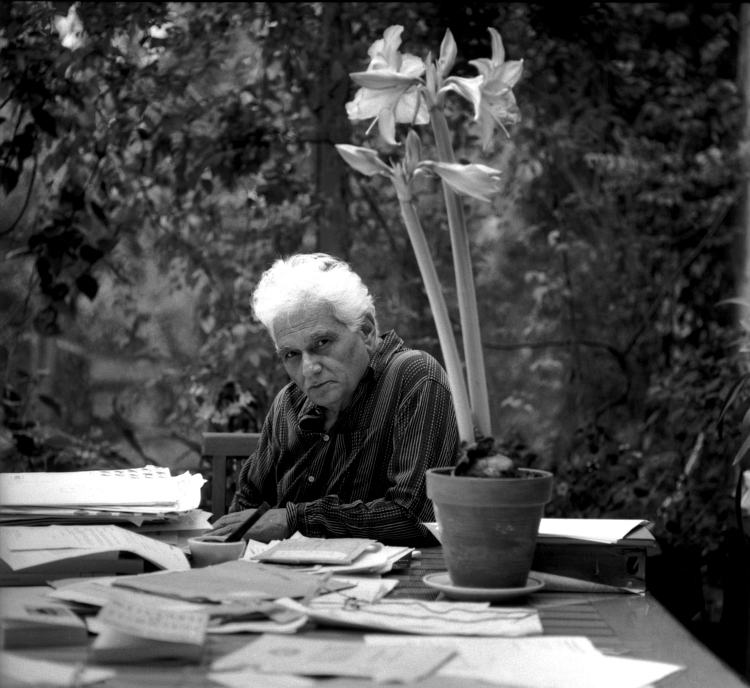
Jacques Derrida's deconstructionism mainly drew on problems in language but the theory can be applied to art, too. No work of art (e.g. Old Shoes with Laces by Vincent van Gogh) has a single set of intrinsic meanings. Rather, there are many possibly conflicting meanings (e.g. whose shoes are depicted?). Works of art are always 'textualised' and cannot be analysed concretely. Why, then, should burning be concretely destructive in art? (Denis Dailleux/Redux)
With this all being said—Heidegger’s philosophy on determinate negation, Derrida’s deconstruction of speech to unravel the essence or universality of certain concepts, and the use of absence and difference—we are led to a realisation: that the act of burning is linkable to the idea of transcending boundaries between construction and destruction. As an art form, burning doesn’t have to be one or the other.
Inspired by Plato’s idea ‘khôra’, Heidegger and Derrida also argued for the representation of a third kind of space—an interval between non-being and being, a clearing, a womb, a matrix, a coming together of ideas in the Being—that gives place to the existence of, for example, scientific and architectural ideas. Gilles Deleuze, too, shared this understanding, recognising the play between absence and presence in what he calls ‘simulacrum’, a concept linked to khôra. ‘Eureka’ moments are born in and thoughts transcend from us; but the world is imitated and distorted, by means of difference, as simulacra first.
By focusing on the end of things and removing binary distinctions, the act of burning—its ‘destruction’—could be said to also construct new meanings and express something authentic, the ontology of which is located in the space between the artist and the context in which they are burning something.
In the context of The Blazing Wing (featured), the essence of the performance announces the removal of binary distinctions. We are asked to question the state of our physicality, particularly in aesthetics, and to ponder how ‘being’ is more present in phenomenology than how it is perceived in reality.
Cultural linkages
.jpg)
A painting (circa 1820) depicting a Hindu funeral procession in India. Antyesti, which translates to 'last sacrifice', refers to the funeral rites for the dead, performed through a process of cremation of the body. Antyesti is often seen as a ritual that breaks the cycle of death and rebirth. (British Museum)
In certain cultures, the act of burning is considered to be embedded within their traditions already—often as an integral part of a religion which has been passed over to present generations.
Perhaps individuals who grew up being exposed to Western pedagogy would consider burning dead bodies more of a process than a ceremony, despite cremation’s commonplace. For many others, however, who have been exposed to cultures outside this domain of thought, burning remains an important part of their histories and is often viewed and appreciated for the belief that is associated with the process rather than the effects.
Through burning, a new possibility after death is raised.
Radical self-expression
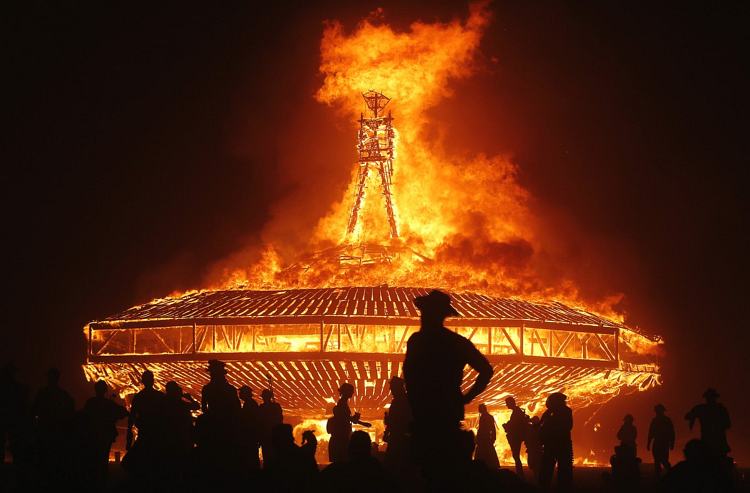
A photograph of the Man burning, taken during the Burning Man 2013 festival. Celebrating its 27th year, it is said that 68,000 people from all over the world gathered at the sold-out event to spend a week in a remote desert, cut off from their ties to the outside world. (Jim Urquhart)
Some ceremonies have made their way into societies that seek to utilise the act of burning to guide and encourage self-expression. One such event is held annually at the Burning Man festival, a week-long event in Black Rock Desert, Nevada (USA). At the festival attendees are encouraged to participate in an experimental community comprising people from all over the world. Participants engage in art-making and observe performances on counterculture, free expression, and celebration of identity.
The community was built on principles such as self-discovery and collaboration, dealing with studies on utopianism and explorations on societal behaviour. However, according to the gathering’s main co-founder, Larry Harvey, Burning Man was intentionally ‘crafted not as a dictate of how people should be and act, but as a reflection of the community’s ethos and culture as it had organically developed since the event’s inception’.
Although the Burning Man gathering itself paves the way to topics outside of death and theoretical and philosophical involvement, as mentioned above, I include it here to provide emphasis to the very symbol that burning forms, which is essential to the fabric of the festival.
Standing out in the midst of art installations, a human effigy lies within the heart of the venue. It will be subjected to a ritual of burning. After being constructed and erected on site by event participants, the effigy is set ablaze to serve as a primal symbol and a metaphor to the principles of the event as to remind people to keep the creative fires burning within themselves long after the event has come to a close.
This, in certain ways, mirrors The Blazing Wing, which instigates a way of associating disappearance with presence through an object—a spectacle.
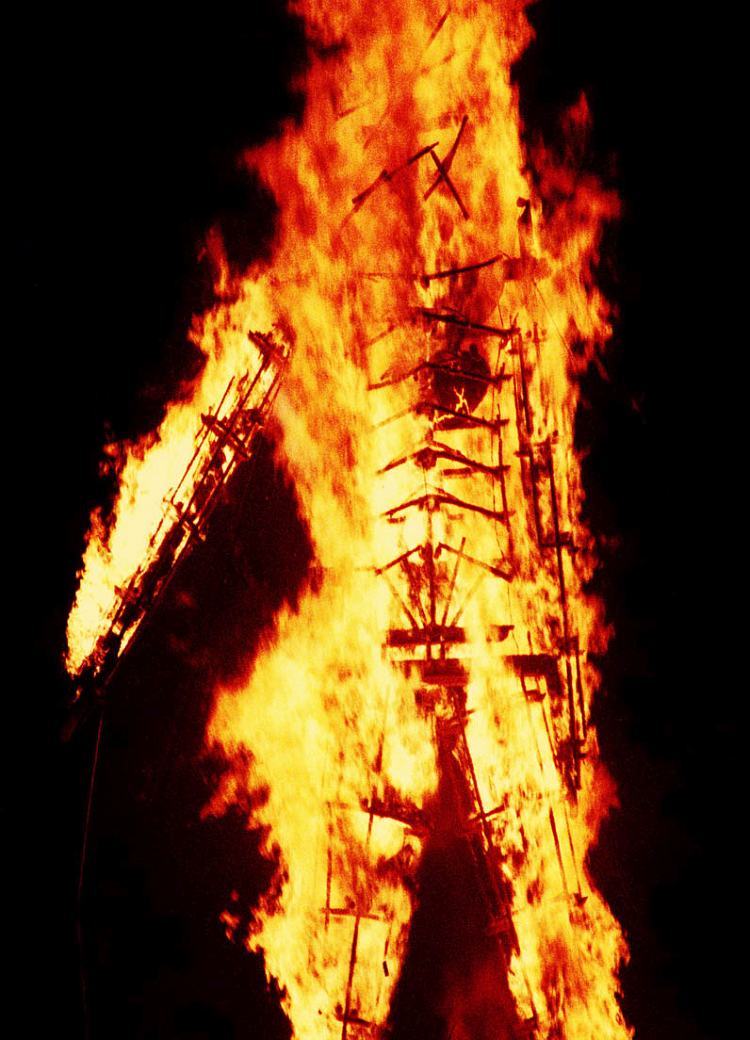
'Burning Man is sort of a newly invented ritual, and its origins have some connections, some argue, to the summer solstice. There is no preconception, according to the organizers, as to what forms of creativity that will take, and it often looks like a festival, or a rave, or a neo-counterculture to people who are encountering it for the first time. So the purpose, number one, is to kind of foster that and experience that for the duration of Burning Man, but then to leave Burning Man with the memory of that. And people then go on to identify as 'burnees,' and there are ways of incorporating Burning Man into your life that go beyond just those eight days. And so in some ways it fulfills—in a modern Western setting—it fulfills a lot of the conditions that we associate with non-Western societies of an annual event that becomes a kind of time and place set apart from daily life. I think it is very important that Burning Man comes to a very empty space, and it leaves it as empty as it was when it arrived. So this notion of a whole city appearing and disappearing more or less overnight is very important to that sense of a temporary experience." — Tavia Nyong'o, Associate Professor of Performance Studies, New York University (C. Lyttle/CORBIS)
What goes on in the Middle?
Although fire and the process of burning have been highlighted, with positive connotations, using constructive ideas throughout the entirety of this article, lest we forget, relevant events, places, and spaces have been devoured by this transient physical element. This includes but is in no way limited to the tragedy caused by the Great Fire of London in 1666 and the day when we all halted at the sight of the Notre-Dame Cathedral of Paris being consumed in flames in 2019.
Events like these are what bring us back to reality and remind us that, no matter how we look at fire, if not controlled, we are exposed as vulnerable and powerless. Is there any consolation to this through an attempt of viewing the process of burning in a constructive stance? I think so.
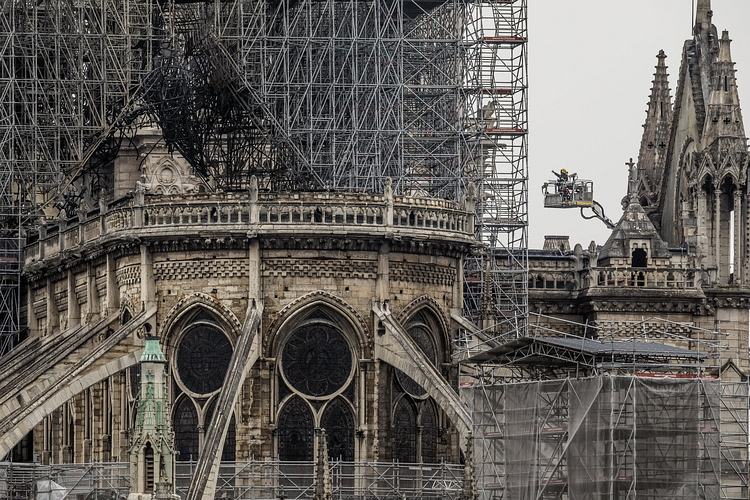
The Notre-Dame Cathedral a day after the blaze. More photos can be found here. (Dan Kitwood/Getty Images)
Fire’s inherent nature to destroy everything within its reach only goes as far as the destruction of physicality. Yet I believe that, when seen through the lens of an observer, one might believe that burning brings an introspective realisation towards the idea of transformation.
Something which lends itself to this idea is a set of concepts I already discussed: Plato’s khôra, Deleuze’s simulacrum—some form of consciousness towards the idea of an interstitial domain between the void and existence that comes into play with watching a burning spectacle of flames which gives rise to new phenomena.
The act of burning can exist as a medium for finality, as described by Heidegger, and ambiguity, as described by Derrida. While the former entices us to realise the importance of eventually reaching denouement because we do exist in it, a sense of comfort can be gained through deeper understandings of the latter concept, which directly deals with an awareness of presence despite impermanence—a theme which quietly remains constant throughout our existence. This awareness is realised in our resolutions: in interstitial space, construction is attained through the very act of physical destruction.
On one hand, we may see the act of burning through theoretical and philosophical introspective involvement, by placing its ‘destruction’ in a transcendent ontic category of artistic or spiritual creation. On the other, we may observe a direct association between the act of burning and how it affects the materiality of its context—in the case of death, by lifting something immaterial about the person (e.g. a soul) from the dead body into a new form.
It is one thing to burn a candle. It is another to be mindfully aware of the changes brought about by the act of burning, which, in self-realisation and radical self-expression, can foreshadow important existential transformation.
By Coop Himmelb(l)au
'You can judge how bad the seventies were by looking at its uptight architecture.
'A democracy of opinion polls and complacency thrives behind Biedermeier façades. We have no desire to build Biedermeier. Not now or no other time. We are tired of seeing Palladio and other historical masks. Because with architecture, we don't want to exclude everything that is disquieting.
'We want architecture that has more. Architecture that bleeds, that exhausts, that whirls, and even breaks. Architecture that lights up, stings, rips, and tears under stress. Architecture has to be cavernous, fiery, smooth, hard, angular, brutal, round, delicate, colorful, obscene, lustful, dreamy, attracting, repelling, wet, dry, and throbbing. Alive or dead.
'If cold, then cold as a block of ice. If hot, then hot as a blazing wing. Architecture must blaze.'

